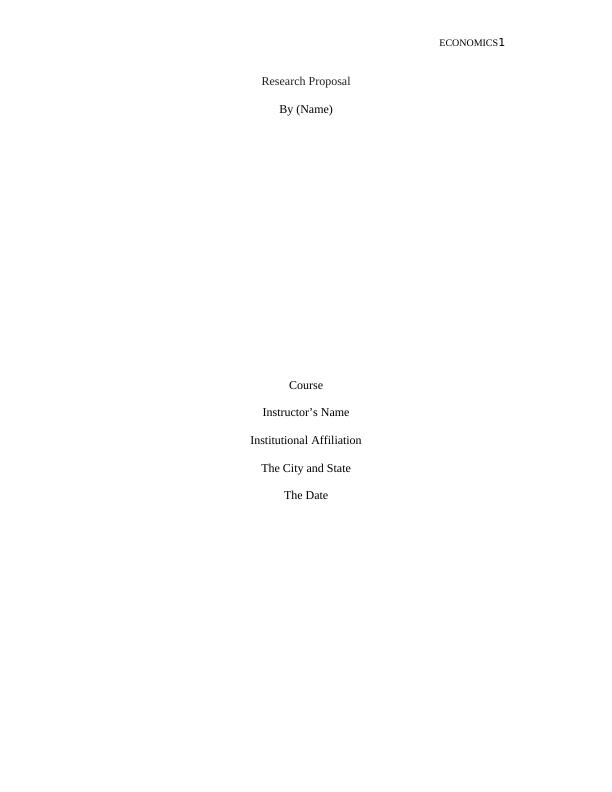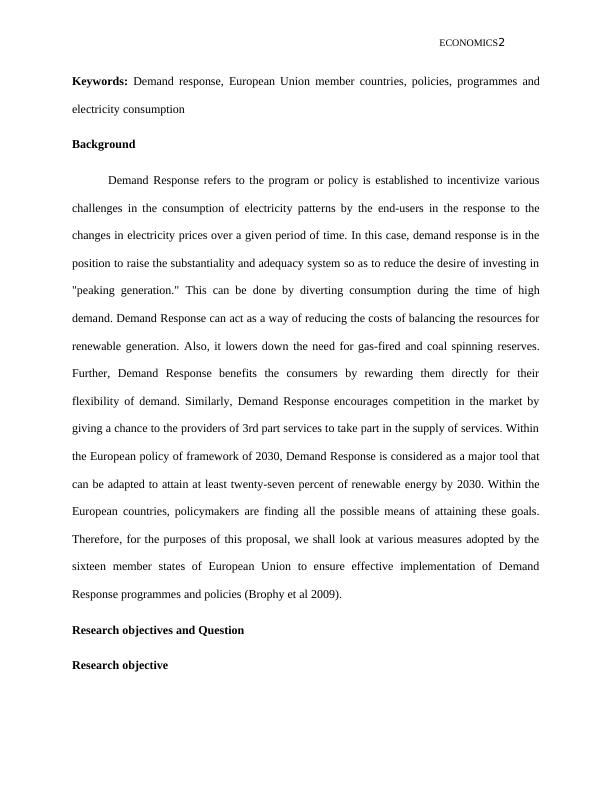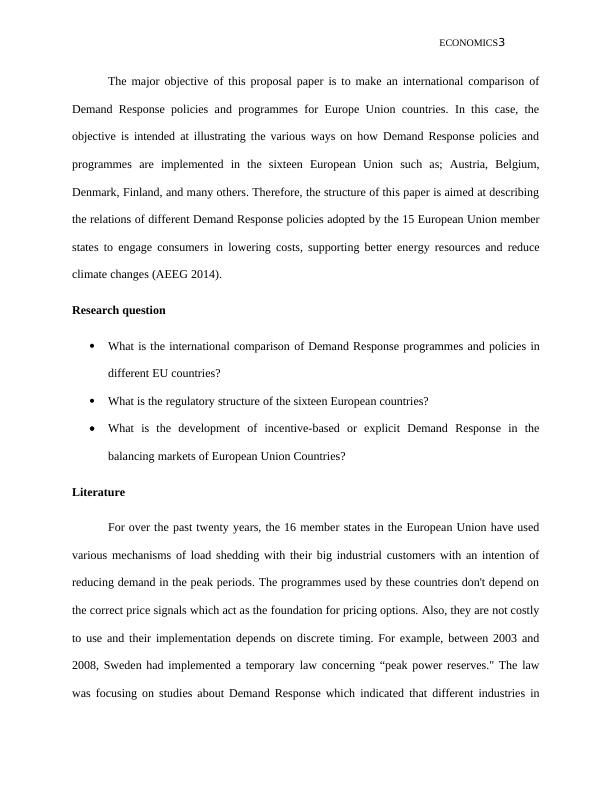Demand Response Policies and Programmes in European Union Countries
Added on 2023-01-03
6 Pages1105 Words91 Views
ECONOMICS1
Research Proposal
By (Name)
Course
Instructor’s Name
Institutional Affiliation
The City and State
The Date
Research Proposal
By (Name)
Course
Instructor’s Name
Institutional Affiliation
The City and State
The Date

ECONOMICS2
Keywords: Demand response, European Union member countries, policies, programmes and
electricity consumption
Background
Demand Response refers to the program or policy is established to incentivize various
challenges in the consumption of electricity patterns by the end-users in the response to the
changes in electricity prices over a given period of time. In this case, demand response is in the
position to raise the substantiality and adequacy system so as to reduce the desire of investing in
"peaking generation." This can be done by diverting consumption during the time of high
demand. Demand Response can act as a way of reducing the costs of balancing the resources for
renewable generation. Also, it lowers down the need for gas-fired and coal spinning reserves.
Further, Demand Response benefits the consumers by rewarding them directly for their
flexibility of demand. Similarly, Demand Response encourages competition in the market by
giving a chance to the providers of 3rd part services to take part in the supply of services. Within
the European policy of framework of 2030, Demand Response is considered as a major tool that
can be adapted to attain at least twenty-seven percent of renewable energy by 2030. Within the
European countries, policymakers are finding all the possible means of attaining these goals.
Therefore, for the purposes of this proposal, we shall look at various measures adopted by the
sixteen member states of European Union to ensure effective implementation of Demand
Response programmes and policies (Brophy et al 2009).
Research objectives and Question
Research objective
Keywords: Demand response, European Union member countries, policies, programmes and
electricity consumption
Background
Demand Response refers to the program or policy is established to incentivize various
challenges in the consumption of electricity patterns by the end-users in the response to the
changes in electricity prices over a given period of time. In this case, demand response is in the
position to raise the substantiality and adequacy system so as to reduce the desire of investing in
"peaking generation." This can be done by diverting consumption during the time of high
demand. Demand Response can act as a way of reducing the costs of balancing the resources for
renewable generation. Also, it lowers down the need for gas-fired and coal spinning reserves.
Further, Demand Response benefits the consumers by rewarding them directly for their
flexibility of demand. Similarly, Demand Response encourages competition in the market by
giving a chance to the providers of 3rd part services to take part in the supply of services. Within
the European policy of framework of 2030, Demand Response is considered as a major tool that
can be adapted to attain at least twenty-seven percent of renewable energy by 2030. Within the
European countries, policymakers are finding all the possible means of attaining these goals.
Therefore, for the purposes of this proposal, we shall look at various measures adopted by the
sixteen member states of European Union to ensure effective implementation of Demand
Response programmes and policies (Brophy et al 2009).
Research objectives and Question
Research objective

ECONOMICS3
The major objective of this proposal paper is to make an international comparison of
Demand Response policies and programmes for Europe Union countries. In this case, the
objective is intended at illustrating the various ways on how Demand Response policies and
programmes are implemented in the sixteen European Union such as; Austria, Belgium,
Denmark, Finland, and many others. Therefore, the structure of this paper is aimed at describing
the relations of different Demand Response policies adopted by the 15 European Union member
states to engage consumers in lowering costs, supporting better energy resources and reduce
climate changes (AEEG 2014).
Research question
What is the international comparison of Demand Response programmes and policies in
different EU countries?
What is the regulatory structure of the sixteen European countries?
What is the development of incentive-based or explicit Demand Response in the
balancing markets of European Union Countries?
Literature
For over the past twenty years, the 16 member states in the European Union have used
various mechanisms of load shedding with their big industrial customers with an intention of
reducing demand in the peak periods. The programmes used by these countries don't depend on
the correct price signals which act as the foundation for pricing options. Also, they are not costly
to use and their implementation depends on discrete timing. For example, between 2003 and
2008, Sweden had implemented a temporary law concerning “peak power reserves." The law
was focusing on studies about Demand Response which indicated that different industries in
The major objective of this proposal paper is to make an international comparison of
Demand Response policies and programmes for Europe Union countries. In this case, the
objective is intended at illustrating the various ways on how Demand Response policies and
programmes are implemented in the sixteen European Union such as; Austria, Belgium,
Denmark, Finland, and many others. Therefore, the structure of this paper is aimed at describing
the relations of different Demand Response policies adopted by the 15 European Union member
states to engage consumers in lowering costs, supporting better energy resources and reduce
climate changes (AEEG 2014).
Research question
What is the international comparison of Demand Response programmes and policies in
different EU countries?
What is the regulatory structure of the sixteen European countries?
What is the development of incentive-based or explicit Demand Response in the
balancing markets of European Union Countries?
Literature
For over the past twenty years, the 16 member states in the European Union have used
various mechanisms of load shedding with their big industrial customers with an intention of
reducing demand in the peak periods. The programmes used by these countries don't depend on
the correct price signals which act as the foundation for pricing options. Also, they are not costly
to use and their implementation depends on discrete timing. For example, between 2003 and
2008, Sweden had implemented a temporary law concerning “peak power reserves." The law
was focusing on studies about Demand Response which indicated that different industries in

End of preview
Want to access all the pages? Upload your documents or become a member.
Related Documents
Benefits and Challenges of Smart Grid Managementlg...
|3
|739
|59
Managing Energy Resourceslg...
|15
|3505
|43
Prices and Markets Demand : Assignmentlg...
|6
|1295
|74
Recent Innovations in Power Supplylg...
|13
|3763
|1
Simulation of Renewable Energy Sources using Home Prolg...
|12
|2216
|78
Australia’s Stand on Renewable Energylg...
|8
|1487
|444
